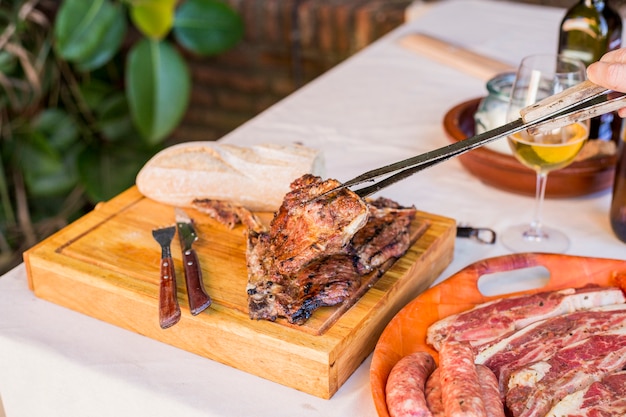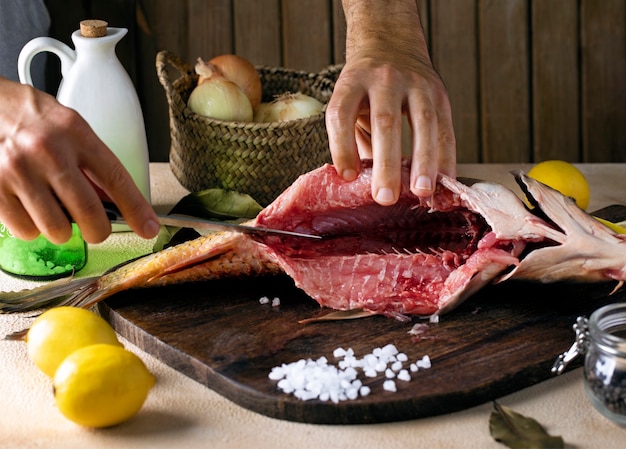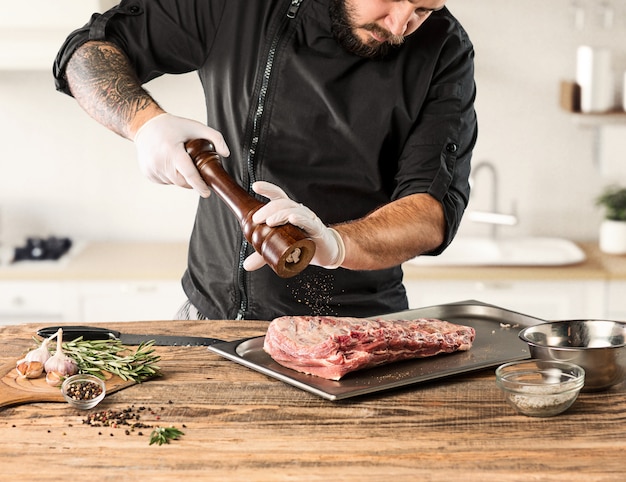Let's face it, there's nothing quite like a perfectly cooked prime rib. It’s a centerpiece that commands attention, a dish that screams "celebration!" But when you’re dealing with a 10lb roast, it can feel like a daunting task. Getting the timing right, achieving that glorious crust, and ensuring the meat is juicy and tender – it all seems a bit overwhelming, right? But fear not! I've got you covered, and I’m here to walk you through every step of the process, making it easier than you think.
I've been cooking prime rib for years, and I’ve learned a thing or two. From choosing the right cut to carving it like a pro, I'm sharing all my secrets to help you achieve that succulent, melt-in-your-mouth masterpiece. So, grab your apron, put on your favourite playlist, and let's get cooking!
(Part 1) The Prime Rib: Choosing Your Weapon

Choosing the Right Cut
First things first, let’s talk about the star of the show – the prime rib. This is the foundation of your culinary triumph, so you need a good quality cut. I'm a bit of a traditionalist when it comes to prime rib. I always go for a bone-in cut. The bone helps to distribute the heat more evenly and gives the meat that incredible, rich flavour you just can't get with boneless cuts. Think of it as a flavour conductor, bringing the deliciousness to every bite.
Look for a cut that’s at least 3 inches thick. A 10lb roast will usually give you enough to feed 8-10 people, so that’s what we’re aiming for today. Now, here’s where things get interesting. You need to find a roast that’s well-marbled with good fat coverage. This is key, my friend! That fat will render during cooking, adding flavour and keeping the meat unbelievably moist. It's a beautiful cycle of deliciousness!
The Butcher's Touch
Now, if you're feeling a bit fancy, ask your butcher to tie the roast for you. They'll use butcher’s twine to tie the roast into a nice, neat shape. It’s like giving your prime rib a little hug! This helps keep the roast from losing its form during cooking. It also gives you a more even cook and helps you to achieve that glorious crust.
If you're buying the roast from a supermarket, you might find it’s already tied. But if not, don’t sweat it. You can easily tie it yourself with some butcher’s twine. You’ll find it in the same aisle as the meat. Just grab some, watch a quick YouTube tutorial, and you’ll be a pro in no time!
(Part 2) Prepping the Roast

Seasoning
Alright, your prime rib is ready to go. Now, it’s time to get seasoning. I’ve tried lots of different spice blends over the years, but I always find myself going back to the classics. Salt and pepper are your best friends, and they really bring out the natural flavour of the meat. I always use kosher salt, and I go heavy on the black pepper. But feel free to experiment with your favourite herbs and spices.
You can also add a touch of garlic powder and onion powder to your rub. I like to add a little bit of dried rosemary for a touch of earthiness. It's all about creating that flavour profile that speaks to you. Just be sure to rub the spices all over the roast, making sure to get every nook and cranny.
Now, here’s where things get interesting. I’m a firm believer in letting the prime rib sit in the fridge, uncovered, for at least 24 hours. This allows the salt to draw out moisture from the meat and then reabsorb it, making the roast incredibly juicy. It’s like a little magic trick for deliciousness! It's called a "dry brine," and it's a game-changer.
(Part 3) Getting Ready to Cook

The Oven
Now, your roast is prepped and seasoned. It’s time to start thinking about the oven. You’ll want to preheat your oven to 450°F (232°C). The high heat will give you that perfect sear, creating a delicious crust that’s both crispy and flavorful.
And here’s a little tip: use a roasting pan with a rack. This will help the air circulate evenly around the roast, ensuring that it's cooking evenly on all sides. You don't want any parts of your roast to be undercooked or overcooked.
roasting time!
Time to get that roast in the oven. Before you do, make sure to put a cup of water in the bottom of your roasting pan. This will create steam during the cooking process, helping to keep the meat moist. It's a little trick to lock in that juicy goodness.
Now, here’s the important bit: the cooking time. For a 10lb prime rib, you’ll need to cook it for about 2-2.5 hours. But here’s the thing, everyone's oven is different. So, the most important thing to remember is to cook the roast to the desired internal temperature.
You can use a meat thermometer to check the temperature. For medium-rare, you’ll want the internal temperature to be around 135°F (57°C). For medium, it’s 140°F (60°C). And for medium-well, it’s 145°F (63°C).
The Rest
The secret to juicy, tender prime rib is letting it rest. Once the roast reaches the desired internal temperature, take it out of the oven and let it rest for at least 15-20 minutes before carving. This allows the juices to redistribute throughout the meat, ensuring that every slice is incredibly tender and flavorful. It makes all the difference.
(Part 4) Carving Perfection
The Tools of the Trade
Now, you’re almost there. It’s time to carve that masterpiece. You'll need a sharp carving knife and a carving fork. I recommend using a carving knife with a slightly curved blade. It makes it easier to slice through the meat without tearing it.
If you’re a bit intimidated by carving, don’t worry, I’ve got you covered. Start by cutting off the ends of the roast. Then, use your carving knife to make thin slices across the grain of the meat. And remember, go slow and steady. You don't want to tear the meat.
Presentation
Now you’ve got beautiful slices of prime rib. Time to put it on a platter. You can arrange the slices in a fan shape for a beautiful presentation.
If you have a bit of the pan juices left in the roasting pan, you can strain them into a gravy boat and serve them alongside the roast. It’s a great way to add another layer of flavour and create a beautiful, aromatic experience for your guests.
(Part 5) Serving Time
side dishes
Now, your prime rib is ready to be devoured. You've got the main course covered, so now it's time to think about the sides. I like to keep my sides simple. I always serve roasted vegetables. I think they go great with the richness of the prime rib. A classic potato gratin or a simple salad also works really well.
The Wine Pairing
Now, we’re talking about the finer things in life! What could go better with a prime rib roast than a delicious red wine? I always go for a Cabernet Sauvignon, but Merlot or Pinot Noir also work beautifully.
You want a wine that will complement the flavour of the roast without overpowering it. A good red wine will enhance the richness of the prime rib and create a beautiful symphony of flavour. And don’t forget, it's about the company, too. Enjoy your special occasion with loved ones!
(Part 6) prime rib leftovers
Don’t Waste a Bit!
Let’s be honest, sometimes you make a bit too much prime rib. It happens! But don't worry, there’s no need to waste any of that deliciousness.
Reheating
I like to reheat the prime rib in the oven at a low temperature. You can also reheat it in a skillet with a little bit of butter. You can also slice it up and use it in sandwiches or salads. It's a versatile ingredient that can be enjoyed in countless ways.
Prime Rib Hash
If you’re looking for something a little more creative, you can make a prime rib hash. Dice up the leftover roast, along with some potatoes, onions, and peppers. Then, fry it all up in a pan with a little bit of olive oil. It’s a delicious way to use up leftover prime rib and it's super easy to make.
(Part 7) Prime Rib Mistakes and Solutions
Dry Roast?
So, you've put in all the effort, but your prime rib came out a little dry? It happens to the best of us! Here’s the thing, if you’ve undercooked the roast, you can always put it back in the oven. But if it’s overcooked, there’s not much you can do. But there are ways to make it more palatable!
Try adding a little bit of gravy or a pan sauce to make it more moist. You can also use a slice of bread or a potato to absorb some of the excess juices.
Not Enough Crust?
Not getting that perfect, crispy crust? It’s all about that sear! If your crust isn’t quite there, you can try searing the roast again before you serve it. Just pop it under the broiler for a few minutes. It will give you a nice, crispy crust on the outside.
Overcooked?
You've gone a little overboard and the roast is overcooked? It’s not the end of the world. You can make a delicious prime rib sandwich or hash. Remember, there’s always a solution!
(Part 8) prime rib faqs
How long does it take to cook a 10lb prime rib?
A 10lb prime rib typically takes around 2-2.5 hours to cook in a 450°F (232°C) oven. However, the best way to determine the cooking time is to check the internal temperature with a meat thermometer. Aim for an internal temperature of 135°F (57°C) for medium-rare, 140°F (60°C) for medium, and 145°F (63°C) for medium-well. Remember, the key is to cook it to your desired level of doneness.
What temperature should I cook prime rib at?
Start by preheating your oven to 450°F (232°C) to get that perfect sear. Then, reduce the temperature to 325°F (163°C) and continue cooking until the roast reaches your desired internal temperature. Remember, it’s all about the internal temperature.
How do I tell if prime rib is done?
The best way to tell if your prime rib is done is to use a meat thermometer. For medium-rare, aim for an internal temperature of 135°F (57°C). For medium, aim for 140°F (60°C). And for medium-well, aim for 145°F (63°C).
Can I cook prime rib in a slow cooker?
While you can technically cook prime rib in a slow cooker, it's not ideal. The slow cooker doesn't get hot enough to give you a nice sear. And because it cooks at a lower temperature for longer, you may end up with a more dry roast.
What are some good side dishes for prime rib?
Prime rib pairs well with a variety of side dishes. Some classic choices include roasted vegetables, mashed potatoes, potato gratin, and salads. You can also go for a more adventurous option like asparagus spears with hollandaise sauce.
(Part 9) Prime Rib: A culinary journey
Cooking a prime rib is more than just a recipe; it’s a culinary journey. It’s about taking the time to choose the right ingredients, mastering the techniques, and creating a dish that’s both delicious and impressive. I hope this article has given you the confidence to tackle your next prime rib roast and create an unforgettable dining experience. So, what are you waiting for? Go forth, embrace the challenge, and enjoy the fruits of your culinary labour!
Everyone is watching

Corn on the Cob: The Ultimate Guide to Perfectly Cooked Ears
Healthy MealsAh, corn on the cob. Just the name evokes images of sunny days, barbecues, and that sweet, juicy flavour that ...

Perfect Pork Roast Oven Cooking Time: A Guide to Delicious Results
Healthy MealsThere's something truly satisfying about a perfectly roasted pork. The aroma alone is enough to make your mout...

Ham Cooking Time: How Long to Bake, Smoke, or Boil a Delicious Ham
Healthy MealsAh, ham. It's a classic, isn't it? A real crowd-pleaser, especially around holidays. And when done right, it'...

Scallops: The Ultimate Guide to Perfect Cooking
Healthy MealsAh, scallops. Those delicate, sweet, and utterly delicious morsels of the sea. They hold a special place in my...

Spaghetti Squash: The Ultimate Guide to Cooking and Serving
Healthy MealsRemember that time you saw spaghetti squash at the supermarket, looking all bumpy and strange, and thought, "W...
